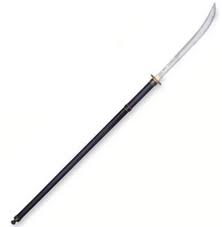Pole-arm

A Pole-Arm technically refers to any type of weapon consisting of a metal head with a long wooden pole. Spears technically fall under this classification, but more often than not it is used to refer to weapons with something more than just a point intended for poking at the end and can also be used to chop and hack. These include axe heads, spikes and sword blades. Pole arms have been used by numerous civilizations, including Europeans, Turks, Russians, Chinese and Japanese.
Pole-arms in warfare
When compared to spears, pole-arms retain some of the advantage of reach while gaining more flexibility in how they attack. While a spearman is limited to simply poking his enemies to death, the Pole-armed soldiers can also hack or slash. This generally comes at the price of a somewhat shortened reach.
Types of Pole-arm
Spears are far from being the only form of polearm- there are numerous others, most of which tend to be obsucre and difficult to distinguish. A short list of some of the more notable types is as follows:
- Poleaxe: It's an axe head on a pole, just as the name suggests. Compared to a halberd, it has a smaller head, which focuses kinetic energy onto a smaller area and lets it cut through armor more effectively. The spike on the end of the pole's butt also made it useful for thrusting attacks, and it could be used to block in the same way as a quarterstaff.
- Halberd: Another pole-arm, differing from the poleaxe in the long spike on the top of the axe head and the hook on the back of the axe's blade, which was ideal for pulling a mounted knight off his horse. It could be used as a spear as well as an axe in close quarters.
- Lance: A bigger, heavier spear intended for knights and other mounted warriors. They were too bulky to be wielded on foot and too heavy to throw, relegating them to use on horseback; however, they could be absolutely devastating during a cavalry charge. Variations of the lance continued to be used until World War I. They were also the go-to weapon for jousting tournaments.

- Pike: Perhaps the most effective of the pole weapons, the pike was a very long (about 10-25 feet long) spear that was ideal for defensive maneuvers, especially when wielded en masse- each rank of pikemen was trained to hold their pikes so any enemy infantry had to deal with more sharp pointy objects than a hedgehog convention pointed at them. However, the tight formations made them vulnerable to archers and could not effectively defend themselves if outflanked. Nevertheless, their lethality and defensive skill made them popular into the late 1600s, at which time standing around in dense formations made pikemen an easy target for arquebusiers and artillery. Both the Landsknechts and the Swiss became famous for their proficiency with pikes.